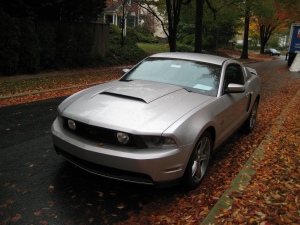 When I began the process of setting up this site and creating a schedule of which cars to review, I wanted to take an in-depth look at one of the most iconic American cars, the Ford Mustang. Introduced in 1964, the Mustang broke sales records in its first year of production. The Ford Mustang has a distinct shape to it, and throughout the years it has developed a cult following, even outliving its competition. Each iteration of the Mustang has continued major design themes, based on the original’s short-trunk lid/long hood design. When Ford redesigned the Mustang for the 2005 model year, they melded visual attributes of the 1967-1969 Mustangs with modern running gear and electronics. Now the 2010 model has been introduced, with some very visible changes from its predecessor both inside and out, but do they make it better?
When I began the process of setting up this site and creating a schedule of which cars to review, I wanted to take an in-depth look at one of the most iconic American cars, the Ford Mustang. Introduced in 1964, the Mustang broke sales records in its first year of production. The Ford Mustang has a distinct shape to it, and throughout the years it has developed a cult following, even outliving its competition. Each iteration of the Mustang has continued major design themes, based on the original’s short-trunk lid/long hood design. When Ford redesigned the Mustang for the 2005 model year, they melded visual attributes of the 1967-1969 Mustangs with modern running gear and electronics. Now the 2010 model has been introduced, with some very visible changes from its predecessor both inside and out, but do they make it better?
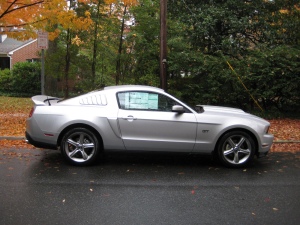 For 2010, Ford has given one of its longest continuously-running nameplates a refreshing, almost a complete redesign. Ford has changed the body slightly, to make the car look smaller and reshaping the front and rear ends to look more modern. While this gets slightly away from the mostly retro look of the 2005-2009 Mustang, it makes the car appear more aggressive, and in my opinion, much better. The front end slopes a little bit more forward, giving a more shark-nosed appearance, and a hood bulge adds more muscle to an already tough-looking car. The doors and roof line retain their previous shape, but out back the rear end is now sloped inward from the rear bumper towards the trunk lid. While retaining the classic vertical taillights that Ford brought back in the 1996 model year, they are separated by white bars, and are sequential, a feature Ford has used before. The sequential taillights illuminate from the innermost to the outermost lamp, giving the Mustang a distinctive appearance, especially at night.
For 2010, Ford has given one of its longest continuously-running nameplates a refreshing, almost a complete redesign. Ford has changed the body slightly, to make the car look smaller and reshaping the front and rear ends to look more modern. While this gets slightly away from the mostly retro look of the 2005-2009 Mustang, it makes the car appear more aggressive, and in my opinion, much better. The front end slopes a little bit more forward, giving a more shark-nosed appearance, and a hood bulge adds more muscle to an already tough-looking car. The doors and roof line retain their previous shape, but out back the rear end is now sloped inward from the rear bumper towards the trunk lid. While retaining the classic vertical taillights that Ford brought back in the 1996 model year, they are separated by white bars, and are sequential, a feature Ford has used before. The sequential taillights illuminate from the innermost to the outermost lamp, giving the Mustang a distinctive appearance, especially at night.
While the exterior designers were giving the bodywork a makeover, the interior design department was definitely not sitting on its laurels. A lot of the interior materials have been improved, replacing hard plastics with soft-touch plastic and leatherette. A satellite navigation system is optional, as are heated seats and dual-zone automatic climate control, among other luxury-oriented options. The fit and finish of the interior has also been improved for 2010, a welcome change from past designs.
 Turning the key in the ignition, the 4.6-liter V8 growls to life, filling the cabin with sounds that let your passenger know that he or she is in for a ride. The gauges in front of you are configurable in color with any of 125 choices, which while it could be gimmicky, aids the driver by letting them pick colors which are of better contrast than some other gauges in cars. I changed the gauge background color to green, which contrasts nicely with the red needles on the instrumentation. While the gauge design has dated somewhat since its introduction five years ago, the clarity is still very good. Looking right, you notice that the optional satellite navigation screen has come to life and shows a Mustang logo, followed by the “Home” screen for the in-car entertainment. This is divided up into three sections: the left half of the screen devoted to navigation, the top of the right half showing the audio information, and the lower portion of the right half displaying climate control settings. The screen is big and high-resolution, which makes viewing its contents very easy. The only problem with this screen is its position in the dash. If it higher in the dash, it would be far less of a distraction when actually trying to use the satellite navigation. Many times I left the screen on a menu because the display is out of sight when you’re driving. The regular (standard) radio display sits higher in the dashboard, near where just the top of the navigation screen lies. This would make it a better fit for drivers who don’t need the built-in navigation, important in a car whose main purpose is as a driver’s car. Ford has also added its ambient lighting setup to the Mustang, which includes lighted door sills which say “MUSTANG” and rings of light in the footwells and cupholders. The position of the cupholders presents a problem though; with the cupholder cover opened, you lose most of the armrest when not shifting. This and the placement of the navigation screen seem to be afterthoughts of the designers, marring what would otherwise be an excellent interior to spend some time.
Turning the key in the ignition, the 4.6-liter V8 growls to life, filling the cabin with sounds that let your passenger know that he or she is in for a ride. The gauges in front of you are configurable in color with any of 125 choices, which while it could be gimmicky, aids the driver by letting them pick colors which are of better contrast than some other gauges in cars. I changed the gauge background color to green, which contrasts nicely with the red needles on the instrumentation. While the gauge design has dated somewhat since its introduction five years ago, the clarity is still very good. Looking right, you notice that the optional satellite navigation screen has come to life and shows a Mustang logo, followed by the “Home” screen for the in-car entertainment. This is divided up into three sections: the left half of the screen devoted to navigation, the top of the right half showing the audio information, and the lower portion of the right half displaying climate control settings. The screen is big and high-resolution, which makes viewing its contents very easy. The only problem with this screen is its position in the dash. If it higher in the dash, it would be far less of a distraction when actually trying to use the satellite navigation. Many times I left the screen on a menu because the display is out of sight when you’re driving. The regular (standard) radio display sits higher in the dashboard, near where just the top of the navigation screen lies. This would make it a better fit for drivers who don’t need the built-in navigation, important in a car whose main purpose is as a driver’s car. Ford has also added its ambient lighting setup to the Mustang, which includes lighted door sills which say “MUSTANG” and rings of light in the footwells and cupholders. The position of the cupholders presents a problem though; with the cupholder cover opened, you lose most of the armrest when not shifting. This and the placement of the navigation screen seem to be afterthoughts of the designers, marring what would otherwise be an excellent interior to spend some time.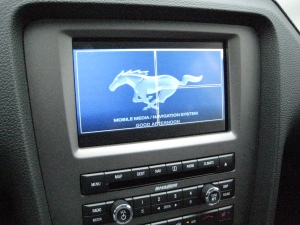
While driving, you’ll notice that the steering is heavier than in most cars, making it easier to get the car to go exactly where you want it by providing more feedback to you, but only slightly more difficult in tight turning situations. You’ll also note an unusually light clutch pedal for a car of this power level, as well as a very direct and accurate gear shifter (on the standard manual transmission), which makes driving in traffic a bit easier. When shifting gears, you’d almost swear there is a conventional metal gate underneath the lever shift boot, guiding you from one gear to the next. It takes a little getting used to, but after several minutes of driving, it was second nature to change gears quickly and smoothly.
With a car like this, you expect more acceleration than most, and the Mustang GT definitely comes through in that regard, but whereas past muscle cars have been rough, noisy and generally rambunctious, the 2010 Mustang is mostly just noisy. The exhaust note is a bit loud for everyday driving, but after spending some time in the car during my commute, I got used to it, and it was less intrusive than when I first picked up the car. The wind noise is still a bit disappointing, especially at highway speeds, but since the Mustang is designed as both a coupe and convertible, this is to be expected.
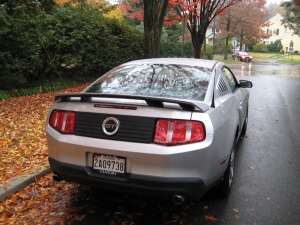 Given that this car can reach some fast speeds in a hurry, it helps to be able to see what’s going on around you, and the Mustang shines here. Rear visibility is great in dry weather, but fairly poor in the rain, when water streaks down the rear glass, blurring the view. The only thing which impedes on the view is the tester’s optional spoiler, which stands up a few inches. Thankfully, the pedestal spoiler is an option, and a lower one can be had with different option packages. Side vision, unlike many of its competitors, is excellent, with just enough height to the side glass that you don’t feel confined or in a cave. Front visibility is good, with the hood and optional hood scope only slightly blocking your view of what lies ahead. At night, the high intensity headlights fitted to the review vehicle provided plenty of light, although the high beams left me wishing they lit up more distant objects.
Given that this car can reach some fast speeds in a hurry, it helps to be able to see what’s going on around you, and the Mustang shines here. Rear visibility is great in dry weather, but fairly poor in the rain, when water streaks down the rear glass, blurring the view. The only thing which impedes on the view is the tester’s optional spoiler, which stands up a few inches. Thankfully, the pedestal spoiler is an option, and a lower one can be had with different option packages. Side vision, unlike many of its competitors, is excellent, with just enough height to the side glass that you don’t feel confined or in a cave. Front visibility is good, with the hood and optional hood scope only slightly blocking your view of what lies ahead. At night, the high intensity headlights fitted to the review vehicle provided plenty of light, although the high beams left me wishing they lit up more distant objects.
Traditionally, Mustangs have been known to go fast in straight lines, and beg for forgiveness when encountering curves. With this latest refresh, Ford has continued to modify the suspension, leaving you with a package that if not relentlessly hammered by series of bumps, will corner very well, especially at the speeds most drivers will be driving their Mustangs at. While driving, if you spot a deer or several, as I did when first taking the Mustang home, you’ll find that the new Mustang’s brakes are definitely up to the task of bringing the car to a halt from the speed limit in a hurry, without introducing any unwanted drama into the maneuver.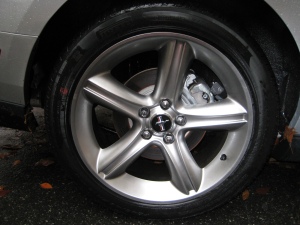
Conclusion:
The tester I drove was just about fully-loaded. Only a few bits and baubles were missing, most notably the backup camera, which is fantastic when paired with Ford’s 8″ touch screen navigation display in other Ford products I’ve driven. This all leads to an as-tested price of $38,710, which is a little hard to swallow. Thankfully, leaving a few options unchecked will yield a car close to $30,000, and the V6 Coupe starts at just under $21,000. Anyone who will be commuting in rush hour traffic should consider an automatic, which on the V8-powered GT gets better gas mileage than its V6 counterpart. If your insurance balks at you having aV8, the V6 is just as sharp looking, if somewhat slower. The 2010 Mustang is an exciting drive, with plenty of muscle and a bit of loudness to remind you that you’re in a sports car, although it almost has too many creature comforts available, given its purpose. Continuing the commuting Mustang, I’d recommend the GT, with the lower spoiler (or none at all), regular radio (or optional Shaker) and the automatic transmission. For anyone looking to get a weekend cruiser, I’d still recommend the GT, and keep in mind that there is a convertible version available, for those who live where the weather permits top-down motoring. The 2010 Mustang definitely continues its tradition as a Pony Car, and now has a strikingly good retro look, backed up with a modern interior and drive train, and all the power anyone would realistically need. For those of you looking for yet more power, look at the Mustang GT500, GT500KR, and any number of Roush and Saleen modified 2010 Mustangs.
Competitors: Chevrolet Camaro, Dodge Challenger
As-Tested:
Year: 2010
Make: Ford
Model: Mustang GT Coupe
EPA Fuel Mileage: 16/24 City/Highway
Base Price: $30,995.00
Options:
$395: Premier Trim w/Color Accent (Rapid Spec 401A)
$395: Security Package (Active Anti-Theft System, Wheel Locks)
$525: HID (High Intensity) headlights
$595: Comfort Package (Heated Seats, Dual-Zone Automatic Climate Control)
$2,195: Electronics Package (Satellite Navigation,
$895: 19″ Premium Painted Wheels
$495: 3.73 Rear Axle Package (faster acceleration)
$1,370: GT Coupe Accessory Package 5 (Decklid Panel, Hood Scoop, Quarter Window Louvers, Side Scoops, Pedestal Rear Spoiler)
Total: $37,860
Destination: $850
As-Tested Price: $38,710
Ford has an online Window Sticker viewer. Click here to view the Window Sticker for the actual test vehicle.
Special thanks to Steve Fransisco and Century Ford of Mt. Airy, MD for loaning the tester to Road Reality. Click here to view their web site.
By John Suit

Good Review. Good luck with the blog.